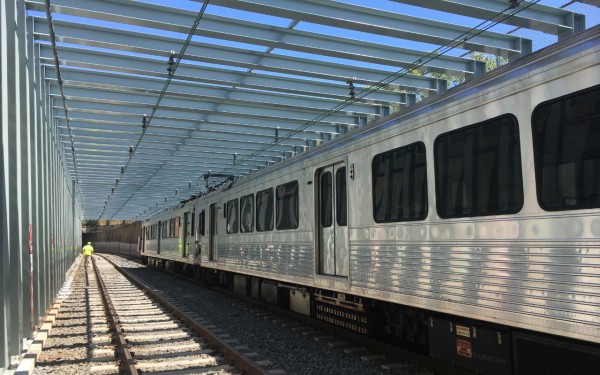Saving Cleveland's Red Line
CE alums help rebuild a failing retaining wall, preserve a busy rail corridor
In May 2019, a 300-foot section of retaining wall along Cleveland's busy Red Line was tipping over. The wall, 20 feet above the Red Line, supports the Norfolk Southern’s New York-to-Chicago mainline, which carries dozens of freight trains and Amtrak passenger trains each day.
Three Purdue Civil Engineering alums would play crucial roles in repairing this busy east-west corridor connecting downtown to the airport.
The Greater Cleveland Rail Transit Authority, known locally as the RTA, was monitoring wall displacement. When alerted to increased movement, Director of Engineering Joe Schaffer (MSCE '86) and Project Engineer Chris Coppock (BSCE '12) hiked out to the affected area. "We took one look and said, 'Whoa, this thing has moved a foot,'" Schaffer says.
Schaffer and the RTA called on trusted colleagues at Great Lakes Construction. When Jim Fox (BSCE '90), vice president of operations for Great Lakes, saw the damaged retaining wall, he too was alarmed. "A big section of wall was starting to fail, and quickly. We needed to act fast," he says.
On Schaffer and Coppock's recommendations, the RTA shut down the busy Red Line — which runs 100 arrivals and departures every day. It was a public inconvenience, and the agency wanted the lines reopened by Labor Day, in time for the Cleveland Browns' first home game. And, although the RTA hoped to preserve both east and west tracks, initial assessments did not look good.
High hurdles
The project presented huge challenges. For one, there was no clear access to the damaged wall. For another, a network of high-voltage overhead wires made crane work dangerous. And because the 20-foot-wide trench didn't allow much clearance, repair materials — and repair design — had to be selected carefully. Work crews had to proceed cautiously to avoid getting boxed into the corridor. Plus, it was the height of the summer construction season, when union work crews were already booked. Compounding it all, the wall-monitoring system showed that the wall was continuing to move.
"In the beginning, while we talked about the size of beams, the clearances and the repair that RTA wanted," Fox says, "there was a point when we all looked at each other and said: 'This might be impossible.' But we kept grinding through, coming up with ideas and coming up with solutions."
Indeed, thanks in large part to the persistence of Purdue alums on the job, the project was completed in seven weeks, five weeks early — with both tracks preserved.
The RTA's Schaffer is impressed and grateful. "They worked two different shifts. And they never stopped. They worked Saturdays and Sundays, all the way through. The project actually finished a few days before Labor Day."
A design solution
Of all the problems, the most crucial required finding a workable design for the narrow railroad corridor. An expert in heavy construction logistics, Fox led discussions on selecting the most suitable type of steel member. The beam needed to be slim, strong and readily available. There was no time for built-to-order beams.
"There wasn't much clearance from the edge of the rail to the wall, so you didn't have a lot of room for a steel member in there," Fox says. "Ultimately, the design engineer came up with a unique strut-type frame. Our challenge was to figure out what size beams to use and what the spacing would be."
The team ended up using an "HP 12 x 53," a steel beam that is 12 inches in depth and weighs 53 pounds per foot, a beam typically used for a pile driving. "It's a nice strong member, and it doesn't take a lot of depth," Fox says. "It was readily available, and we were able to make it work with our design."
Base camp
Fox also had obtained access to the job site, negotiating with the adjacent property owner for use of an isolated trailer storage lot. It was seldom used and overgrown with vegetation and small trees. "Working with my project manager, we sealed that deal. Then we had to make sure we could have a nice, safe working area." They had stone brought in to provide support for the crane, forklifts and manlifts.
Schaffer notes, "They had the whole area cleared and graveled — it looked as neat as your patio."
"It was a production-line-type job with all those frames," Fox says. "We had to get the material delivered there. We had to cut and punch holes in the beams, and everything had to be measured with templates; each one individually had to be measured. It was an assembly line for making that steel up top and then flying it down into position. It was really important to have a base camp where we could do all that work safely. The project required 260,000 pounds of steel."
In persistent pursuit
Fox was able to secure expedited work crews, but due to the summer labor shortage, the crews worked long hours, including weekends. All told, the project required 5,000 hours of labor to repair the Red Line retaining wall.
"I credit the whole team for coming up with a solution," says Fox.
Speaking for the RTA and as a project engineer, Schaffer was more than pleased with the outcome. "I knew we needed a heavy-highway firm that was large enough to execute the steel work required, but also attentive to details — and able to develop a solution to a problem that some said couldn't be resolved," Schaffer says. He was pleased to work with a fellow Purdue grad. "It is a great feeling working with people trained to get things done."

